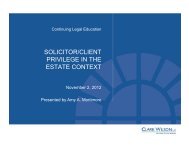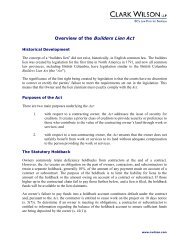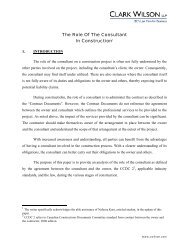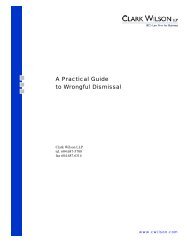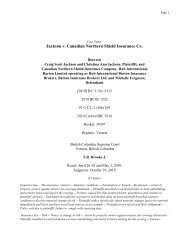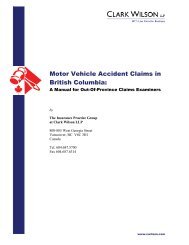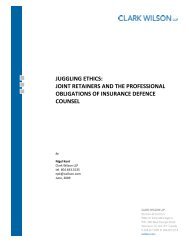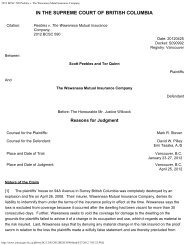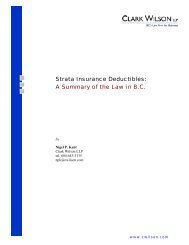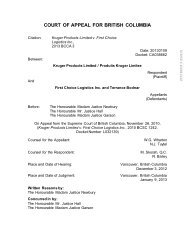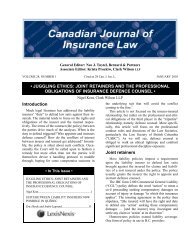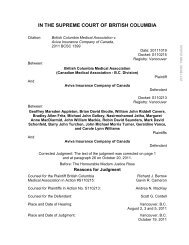AN OVERVIEW OF CONSTRUCTION CLAIMS: - Clark Wilson LLP
AN OVERVIEW OF CONSTRUCTION CLAIMS: - Clark Wilson LLP
AN OVERVIEW OF CONSTRUCTION CLAIMS: - Clark Wilson LLP
Create successful ePaper yourself
Turn your PDF publications into a flip-book with our unique Google optimized e-Paper software.
p. 8<br />
VI.<br />
<strong>CLAIMS</strong><br />
A. DIFFERING SITE CONDITIONS<br />
During the construction of a project, contractors often encounter subsurface or hidden conditions<br />
which were not anticipated and which may have a major impact on the time and cost of<br />
performing their work.<br />
1. Types Of Differing Site Conditions<br />
There are two general categories of differing site conditions:<br />
(a) Conditions that materially differ from those indicated in the contract documents –<br />
this category relates to conditions that differ materially from the conditions<br />
anticipated by the parties when they entered into the contract; and<br />
(b)<br />
Conditions that materially differ from what is typical in the circumstances and<br />
hence were not anticipated nor included in the contract.<br />
What is considered to be “materially different” is a question of fact determined by the court. An<br />
industry expert from the United States has suggested that where a variation of quantities in<br />
excess of 30 percent can be demonstrated, courts are likely to find a material difference 10 .<br />
The situations giving rise to the two categories of differing site conditions claims are not<br />
inherently different, but have to do with the basis for the analysis: for category #1, the basis of<br />
analysis is the contract documents; and for category #2, the basis of analysis involves<br />
consideration of what is normally expected in the circumstances.<br />
2. Category #1 Conditions – What Was Indicated In The Contract Documents<br />
As I will discuss below, the assumption that a contractor may rely on and plan the work based on<br />
conditions anticipated by the contract is reflected in General Condition 6.4 of the CCDC 2 (“GC<br />
6.4”). If the actual conditions encountered by the parties are materially different from those<br />
contemplated in the contract, then recovery may be achieved via the provisions in GC 6.4.<br />
In order to succeed at a claim for this category, the trend in the Canadian jurisprudence suggests<br />
that the contractor must prove that he could not have reasonably anticipated the conditions<br />
actually encountered, despite careful consideration of the contract documents 11 .<br />
The most common problems in this category are subsurface soil conditions and hidden utility<br />
lines. Specific examples of problems in this category include the following 12 13 :<br />
10<br />
11<br />
12<br />
Differing Site Conditions: Quantifying the Material Difference, 11 Construc. Claims Monthly 1 (Mar.<br />
1989).<br />
Adverse Site Conditions, Irvin E. Richter, (1984) 4 C.L.R.<br />
Adverse Site Conditions, Irvin E. Richter, (1984) 4 C.L.R at pp 4-6.<br />
© 2005 <strong>Clark</strong> <strong>Wilson</strong> <strong>LLP</strong> www.cwilson.com<br />
Samantha Ip, T. 604.643.3172



